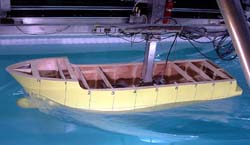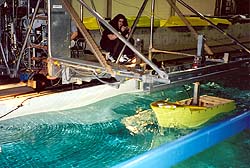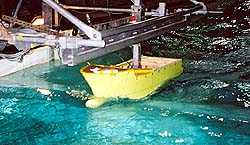 I recently returned from tank testing the new Inace Yachts 93 hull design which we ran with and without bulb. We had a "bulb specialist" design the bulb and he was
present during all the tests.
I recently returned from tank testing the new Inace Yachts 93 hull design which we ran with and without bulb. We had a "bulb specialist" design the bulb and he was
present during all the tests. I have been reading about and studying the bulb issue for a number of years and have spoken to designers, surveyors and other captains about the merits and problems of bulbs. I have to say that going into the test that I was very ambivalent about the benefits that a bulb would provide in a real world situation on a vessel with this water line length. I am in agreement with the experts who feel that you need a water line length of at least 100' to get good all around benefits from the bulb. The specialist feels they enhance a vessel of any length. As we discussed it, we agreed to let the numbers show the way, as the specialist said "numbers do not lie", I was thinking "You can make numbers say anything you want".
 When the results came in the specialist showed them to us and stated, as the number showed, there was a maximum of 20% decrease in resistance with the bulb, he was right and this would overwhelmingly give value to the addition of a bulb. The question raised was "At what speed was the 20% increase was achieved?" It turned out that it was above 11.5 knots, in the high end of the HP curve, the most efficient speed for the boat is 10 to 10.5 knot and in this range the difference was only 10%. Cost of the bulb would be about $7000, vessel burns about 2 gallons per NM at 10 knots. If you used 10,000 gallons per year (5000nm) you would save 1000 gallons a year, at a average cost of $1.00 per gallon, it would take you 7 years to pay back the cost of the bulb, not a good investment.
When the results came in the specialist showed them to us and stated, as the number showed, there was a maximum of 20% decrease in resistance with the bulb, he was right and this would overwhelmingly give value to the addition of a bulb. The question raised was "At what speed was the 20% increase was achieved?" It turned out that it was above 11.5 knots, in the high end of the HP curve, the most efficient speed for the boat is 10 to 10.5 knot and in this range the difference was only 10%. Cost of the bulb would be about $7000, vessel burns about 2 gallons per NM at 10 knots. If you used 10,000 gallons per year (5000nm) you would save 1000 gallons a year, at a average cost of $1.00 per gallon, it would take you 7 years to pay back the cost of the bulb, not a good investment.
So maybe no bulb, however in the sea keeping test we did acceleration tests at the bow, amidships and stern. There was a marked decrease in G forces at the bow with the bulb. Numbers in sea state 5 (8' to 13') at 9 knots with the bulb were similar to numbers in sea state 3 at 9 knots without. However this was at the bow, amidships were our pilothouse is located and master stateroom is the difference was much less. Slowing the boat down to 8 knots would give you the same results. At no time during the test did we get water on the bow, pull the bulb out of the water or put the transom under, so the vessel was well balance in either form.
 Another benefit to the bulb is it is designed to be totally independent of the hull, so if you should hit a container and damage the bulb, you will not have hurt the vessel.
Another benefit to the bulb is it is designed to be totally independent of the hull, so if you should hit a container and damage the bulb, you will not have hurt the vessel.
NEGATIVES OF THE BULB, they can slam when they come out of the water. The bulb specialist (he is quite good) design greatly reduce the possibility of slamming by giving a slight V to the bottom and top of the bulb, why the top, I learned that part of the noise of the slamming that can occur with bulb comes from the water dropping back on the top. The fact that the bulb stayed in the water at the high end test, showed that the boat would have a reduced chance of slamming even without the V. So slamming was not much of a issue.
Chain chaff on vessels with anchor pockets is another problem that can create a great deal of noise at anchor and a need to repaint the bulb often. This can be reduced by use of a coating material that reduces rub and deadens noise. The anchor design on the Inace Yachts reduces this problem as their main anchor is a center line 440 pound CQR and much less likely to rub. The side anchor a 550 pound navy anchor will rub, but it will be used the most in conjunction with the CQR and this should hold it away from the bulb.
In conclusion; the client decided to go with the bulb. His feeling was in the overall price of the vessel the cost of the bulb was minimal. Though the improvements in resistance and pitch were not great, the fact that the vessel might be a bit more comfortable in some condition for his wife and guests made it worth while plus it added the forward bumper.
So bulb or no bulb, the specialist was right; it did enhance the vessel but only to a small degree and in a few circumstances. So in my opinion it depends on the size of the vessel, benefits verses the costs and how important the benefits are to the client. As the client said to me, "If I find the negatives out weigh the positives, I can just remove it."
For another opinion on the matter: Bray Yacht Design